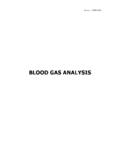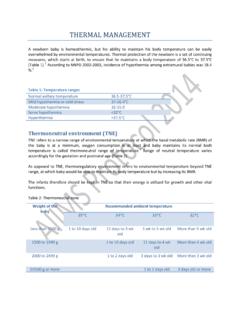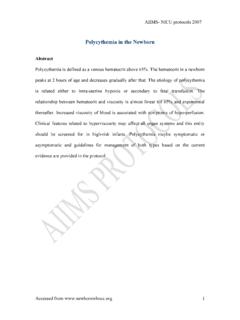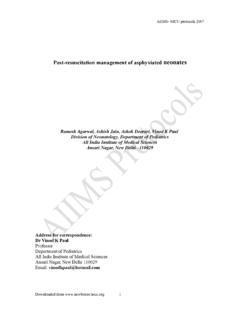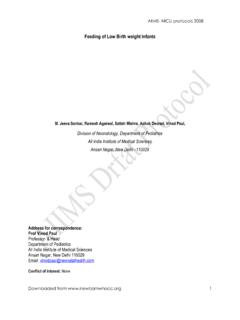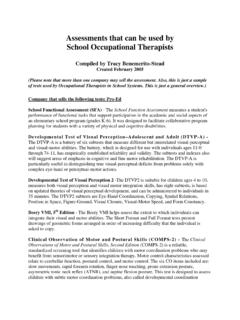Transcription of Approach to inborn errors of metabolism presenting in the ...
1 AIIMS- NICU protocols 2010 Approach to inborn errors of metabolism presenting in the NeonateSuvasini Sharma, Pradeep Kumar, Ramesh Agarwal, Madhulika Kabra, Ashok Deorari, Vinod Paul Department of PediatricsAll India Institute of Medical SciencesAnsari Nagar, New Delhi 110029 Address for correspondenceDr Ashok K DeorariProfessorDepartment of PediatricsAll India Institute of Medical SciencesAnsari Nagar, New Delhi 110029 Email: from AIIMS- NICU protocols 2010 AbstractInborn errors of metabolism (IEM) are an important cause of acute illness in newborns.
2 Presentation may mimic common neonatal conditions such as sepsis. Prompt detection requires a high index of suspicion and the early measurement of biochemical markers such as blood ammonia. Diagnosis is important not only for treatment but also for genetic counselling. Guidelines for diagnosis and early management of IEM presenting in the neonatal period are described. Key words: inborn errors of metabolism , encephalopathy, hyperammonemiaDownloaded from AIIMS- NICU protocols 2010 inborn errors of metabolism (IEM) are disorders in which there is a block at some point in the normal metabolic pathway caused by a genetic defect of a specific enzyme.
3 The number of diseases in humans known to be attributable to inherited point defects in metabolism now exceeds While the diseases individually are rare, they collectively account for a significant proportion of neonatal and childhood morbidity and mortality. Diagnosis is important not only for treatment and prognostication but also for genetic counselling and antenatal diagnosis in subsequent pregnancies. Clinical Presentation:Severe illness in the newborn, regardless of the underlying cause, tends to manifest with non-specific findings, such as poor feeding, drowsiness, lethargy, hypotonia and failure to thrive.
4 IEM should be considered in the differential diagnosis of any sick neonate along with common acquired causes such as sepsis, hypoxic-ischemic encephalopathy, duct-dependant cardiac lesions, congenital adrenal hyperplasia and congenital infections. Clinical pointers towards an underlying IEM include2: Deterioration after a period of apparent normalcy Parental consanguinity Family history of unexplained neonatal deaths Rapidly progressive encephalopathy and seizures of unexplained cause Severe metabolic acidosis Persistent vomiting Peculiar odor (urine, cerumen) Acute fatty liver or HELLP (hemolysis, elevated liver enzymes & low platelet counts) during pregnancy.
5 Seen in women carrying fetuses with long-chain-3-hydroxyacyl-coenzyme dehydrogenase deficiency (LCHADD).Table 1 describes examination findings that may provide a clue to the underlying IEM. Patterns of presentation include2,3:1)Encephalopathy with or without metabolic acidosis: encephalopathy, seizures, and tone abnormalities are predominant presenting features of organic acidemias, urea cycle defects and congenital lactic acidosis. Isolated intractable seizures are prominent in pyridoxine dependency, pyridoxal phopspahte dependency, folinic-acid responsive seizures, and glucose transporter 1 )Acute liver disease: This could manifest as- Jaundice alone- Gilbert syndrome, Criggler-Najjar syndrome Hepatic failure (jaundice, ascites, hypoglycemia, coagulopathy)- Tyrosinemia, galactosemia, neonatal hemochromatosis, glycogen storage disease type IV.
6 Neonatal cholestasis: alpha-1 antitrypsin deficiency, Niemann-Pick disease type C. Hypoglycemia: persistent and severe hypoglycemia may be an indicator of an underlying IEM. Hypoglycemia is a feature of galactosemia, fatty acid Downloaded from AIIMS- NICU protocols 2010oxidation defects, organic acidemias, glycogen storage disorders and disorders of )Dysmorphic features: seen in peroxisomal disorders, pyruvate dehydrogenase deficiency, congenital disorders of glycosylation (CDG), and lysosomal storage diseases.
7 Some IEMs may present with non-immune hydrops fetalis; these include lysosomal storage disorders and )Cardiac disease: cardiomyopathy is a prominent feature in some IEM including fatty acid oxidation defects, glycogen storage disease type II and mitochondrial electron transport chain investigations should be initiated as soon as the possibility is considered. The outcome of treatment of many IEM especially those associated with hyperammonemia is directly related to the rapidity with which problems are detected and appropriate management instituted.
8 First line investigations (metabolic screen):The following tests should be obtained in ALL babies with suspected )Complete blood count: (neutropenia and thrombocytopenia seen in propionic and methylmalonic academia)2)Arterial blood gases and electrolytes3)Blood glucose4)Plasma ammonia (Normal values in newborn: 90-150 g/dl or 64-107 mol/L)5)Arterial blood lactate (Normal values: mmol/L)6)Liver function tests7)Urine ketones8)Urine reducing )Serum uric acid (low in molybdenum cofactor deficiency).
9 Figure 1 gives the algorithmic Approach to a newborn with suspected IEM. Disease category can be diagnosed based on blood ammonia, blood gas analysis and urine ketone testing. Hyperammonemia without acidosis is caused by urea cycle defects. Metabolic acidosis with or without hyperammonemia is a feature of organic acidemias and fatty acid oxidation defects. Figure 2 explains the algorithmic Approach to neonate with persistent hypoglycemia and suspected underlying IEM. Table 2 explains the categorization of IEM based on simple metabolic screening tests.
10 Second line investigations (ancillary and confirmatory tests)These tests need to be performed in a targeted manner, based on presumptive diagnosis reached after first line investigations:Downloaded from AIIMS- NICU protocols 20101)Gas chromatography mass spectrometry (GCMS) of urine- for diagnosis of organic )Plasma amino acids and acyl carnitine profile: by tandem mass spectrometry (TMS)- for diagnosis of organic acidemias, urea cycle defects, aminoacidopathies and fatty acid oxidation )High performance liquid chromatography (HPLC): for quantitative analysis of amino acids in blood and urine.
